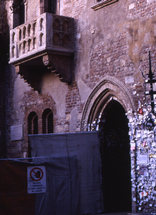Early Modern Circle 2009

Papers for 2009
16 March
Leigh Penman
Strangers Nowhere in the World? Prophecy and the Cosmopolitan Idea in the Sixteenth and Seventeenth Centuries
20 April
Liam Connell
"She was Led by an Evil Spirit": The Curious Case of Mary Bliss Parsons, Northampton, Massachusetts, 1656–1675
18 May
Judith Collard, University of Otago
Matthew Paris's "Self-Portrait with the Virgin Mary" in the Historia Anglorum: Exploring Innovation and Tradition
Matthew Paris, a major figure in thirteenth-century English art, is probably best known for his ambitious and richly iluminated chronicles. Amongst the prefatory material that precedes the Historia Anglorum is an impressive full-page image of the Virgin Mary and Christ with, below them, a praying monk. Unusual in its composition and placement this author portrait highlights several characteristics found within Paris's chronicles, and underlines his knowledge of, and place within the developing traditions of English chronicle& illustration.
15 June
Sue Cole
The Tudor Church Music Revival
17 August
Discussion Session
Cancelled
21 September
Dale Kent
Images of Friendship in Renaissance Florence
19 October
Charlotte Smith
Genealogies, Histories and Cosmographies: Encyclopaedic Images of the Turk
16 November
Andrea Rizzi
Translating the Crusades in Early Modern Italy
The tradition and transmission of William of Tyre¹s Chronicon in the Italian peninsula have been little studied by scholars. It is generally assumed that this extremely important source for the study of the first two crusades was available to medieval and early modern chroniclers working in the Italian peninsula. However, M. Morgan (1973) and P. Edbury (1991) suggest that Marin Sanudo used one of the several French versions and continuations of William¹s work for his early fourteenth-century Liber Secretorum. Further, the Dominican historian Francesco Pipino translated into Latin a French continuation of William¹s Chronicon occupying the twenty-fifth chapter of Pipino¹s opus majus. Through the analysis of the works of Riccobaldo of Ferrara (early fourteenth century), Francesco Pipino of Bologna (early to mid fourteenth century), Giovanni Villani (fourteenth century), Matteo Maria Boiardo (fifteenth century) and Torquato Tasso (sixteenth century), this paper argues that Italian historians and writers did not know William¹s work directly. Instead, these Italian authors relied for their works on some of the French continuations of William¹s Latin text.